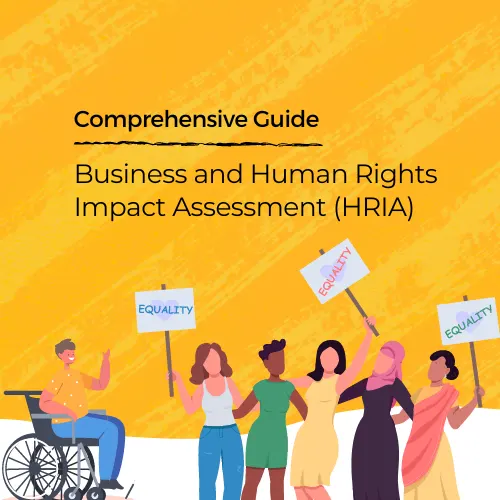
ISO 30414 is an international standard for Human Capital Reporting and Disclosure, covering both internal and external reporting. A human capital or human resource management report enhances communication and transparency by providing insights into an organization’s people performance.
In today’s increasingly competitive business landscape, organisations are constantly seeking ways to enhance and represent their performance to stay ahead.
One powerful standard that can help businesses achieve progress is ISO 30414, a comprehensive framework designed to unlock the potential of human capital reporting and drive organisational success.
In this guide, we will discuss the world of ISO 30414, providing you with a step-by-step roadmap to effectively implement and leverage its strategies to report to both the internal and external world.
From measuring and managing your organisation’s human capital to optimising workforce planning and development, ISO 30414 offers valuable insights and best practices to report your organisational human capital performance.
Whether you are an HR professional, a business leader, or an entrepreneur, understanding and harnessing the power of ISO 30414 will enable you to align your human resource management report with your strategic objectives and achieve extraordinary outcomes. Get ready to transform your organisation by unlocking the full power of ISO 30414.
What You Will Find Here
Understanding the Importance of Organisational Human Capital Performance Reporting
In today’s fast-paced business environment, an organisation’s most valuable asset is its human capital. The skills, knowledge, and expertise of its employees are the driving force behind its success and growth.
However, many organisations struggle to effectively measure, manage, and report on this critical component of their operations. This is where the importance of organisational human capital performance reporting comes into play.
Effective human capital reporting allows organisations to gain a deeper understanding of their workforce, identify areas for improvement, and align their human resources strategies with their overall business objectives.
By measuring and reporting on key performance indicators (KPIs) related to employee engagement, productivity, retention, and development, organisations can make data-driven decisions that optimise their human capital and drive sustainable growth.
Transparency Matters
Moreover, in an era of increasing transparency and accountability, stakeholders, both internal and external, are demanding more comprehensive and reliable information about an organisation’s human capital performance.
Investors, regulators, and the public are increasingly scrutinising an organisation’s human capital management practices, making it crucial for companies to have a robust framework for reporting on this critical aspect of their operations.
Key Components of ISO 30414
ISO 30414 is a comprehensive framework that provides organisations with a standardised approach to human capital reporting. This international standard was developed by the International Organisation for Standardisation (ISO) to help organisations measure, manage, and report on their human capital in a consistent and transparent manner.
At the core of ISO 30414 are six key components that organisations must consider when implementing the standard:
- Workforce Planning and Analytics: This component focuses on the data and metrics organisations need to effectively plan, manage, and develop their workforce, such as workforce composition, skills gaps, and succession planning.
- Talent Acquisition and Mobility: This component covers the processes and metrics related to attracting, recruiting, and retaining top talent, as well as employee mobility and career development.
- Learning and Development: This component addresses the organisation’s efforts to invest in the training, education, and professional development of its employees, and the associated metrics to measure the impact of these initiatives.
- Performance and Potential: This component encompasses the processes and metrics used to evaluate employee performance, potential, and contribution to the organisation’s success.
- Leadership and Workforce Engagement: This component focuses on the organisation’s efforts to foster strong leadership, employee engagement, and a positive work culture.
- Diversity and Inclusion: This component addresses the organisation’s commitment to creating a diverse and inclusive workplace, and the metrics used to measure and report on these efforts.
By addressing these key components, ISO 30414 provides organisations with a comprehensive framework to effectively manage and report on their human capital, enabling them to make informed decisions and drive sustainable growth.
Benefits of Using ISO 30414 for Internal and External Human Capital Reporting
Implementing ISO 30414 can provide organisations with a range of benefits, both for internal and external stakeholders. Here are some of the key advantages of using this standard for human capital reporting:
Internal Benefits
- Improved Workforce Planning and Development: ISO30414 provides organisations with a structured approach to collecting and analyzing data on their workforce, enabling them to make more informed decisions about hiring, training, and succession planning.
- Enhanced Employee Engagement and Retention: By focusing on metrics related to employee engagement, learning and development, and workforce diversity, organisations can better understand and address the needs of their employees, leading to improved retention and job satisfaction.
- Aligning human resources reporting with Strategic Objectives: The framework of ISO 30414 helps organisations to align their human capital management strategies with their overall business goals, ensuring that their investments in human capital are driving the desired outcomes.
External Benefits
- Increased Transparency and Accountability: By adopting ISO 30414, organisations can demonstrate their commitment to transparent and responsible human capital management practices, which can enhance their reputation and build trust with stakeholders.
- Improved Access to Capital: Investors and financial institutions are increasingly interested in an organisation’s human capital performance, as it can be a key indicator of long-term sustainability and growth potential. Compliance with ISO 30414 can help organisations attract and retain investment.
- Regulatory Compliance: In some jurisdictions, organisations may be required to report on their human capital performance (human resources reporting), and ISO 30414 can provide a standardised framework for meeting these regulatory requirements.
By leveraging the benefits of ISO 30414, organisations can not only improve their internal human capital management practices but also enhance their external reputation and competitiveness in the market.
Steps to Follow ISO 30414 in Your Human Capital Reporting
Implementing ISO 30414 in your organisation’s human capital reporting or human resource management report development can be a transformative process. It requires a structured and strategic approach. Here are the key steps to follow:
- Assess Your Current State: Begin by evaluating your organisation’s existing human capital management practices and reporting mechanisms. Identify the strengths, weaknesses, and gaps in your current approach, which will help you prioritise the areas that need the most attention.
- Establish a Cross-Functional Team: Successful implementation of ISO 30414 requires collaboration across various departments, including HR, finance, operations, and IT. Assemble a cross-functional team that can bring diverse perspectives and expertise to the table.
- Align with Organisational Objectives: Ensure that your human capital reporting efforts are closely aligned with your organisation’s strategic objectives and key performance indicators (KPIs). This will help you identify the most relevant metrics and ensure that your human resources reporting efforts are driving the desired business outcomes.
- Identify Relevant Metrics: Refer to the key components of ISO 30414 and select the metrics that are most relevant to your organisation’s needs. This may include metrics related to workforce planning, talent acquisition, learning and development, performance management, and diversity and inclusion.
- Develop Data Collection and Reporting Processes: Establish robust data collection and reporting processes to ensure the accuracy, reliability, and timeliness of your human resource management report data. This may involve integrating various HR and business systems, as well as implementing standardised data collection and reporting protocols.
- Train and Engage Employees: Ensure that your employees, particularly those involved in human capital management and reporting, are trained on the principles and requirements of ISO 30414. This will help to build buy-in and ensure that the implementation is successful.
- Continuously Monitor and Improve: Regularly review and update your human capital reporting processes to ensure that they remain aligned with your organisation’s evolving needs and the changing business landscape. Utilise the insights gained from your reporting to drive continuous improvement and optimisation of your human capital management strategies.
By following these steps, organisations can effectively implement ISO 30414 and leverage its power to unlock the full potential of their human capital, driving sustainable growth and success.
ISO 30414:2018 Human Resource Management – Guidelines for Internal and External Human Capital Reporting
This international standard offers guidelines for both internal and external human capital reporting (HCR), aiming to highlight and make transparent the contribution of human capital to the organisation.
This supports the sustainability and long-term viability of the workforce. These guidelines apply to all organisations, regardless of their type, size, nature, or complexity—whether in the public, private, voluntary sector, or not-for-profit organisations.
This document provides guidelines on the following core HCR areas:
- Compliance and ethics
- Costs
- Diversity
- Leadership
- Organisational culture
- Organisational health, safety and well-being
- Productivity
- Recruitment, mobility and turnover
- Skills and capabilities
- Succession planning
- Workforce availability
These guidelines and associated metrics can result in better organisational performance. However, some organisations do not have the objective or the capacity to use the entire set of metrics. Recommendations for SME use are also provided.
This standard contributes to the following Sustainable Development Goals

This standard is being reviewed by ISO and the Draft International Standard (DIS) is going to be published soon by end 2024.
Common Challenges in Implementing ISO 30414
While the benefits of implementing ISO 30414 are substantial, organisations may face several challenges in the process.
Understanding and addressing these challenges can help ensure a successful implementation and maximise the impact of the standard. Here are some of the common challenges organisations may encounter:
- Data Quality and Availability: Collecting accurate and reliable data on human capital metrics can be a significant challenge for many organisations. Inconsistent data collection processes, siloed information systems, and a lack of data governance can all contribute to data quality issues.
- Resource Constraints: Implementing ISO30414 can be a resource-intensive process, requiring dedicated time, budget, and personnel. Organisations may struggle to allocate the necessary resources, particularly in the face of competing priorities and budgetary constraints.
- Organisational Resistance to Change: Introducing a new reporting framework like ISO 30414 may face resistance from employees who are accustomed to existing practices. Overcoming this resistance and fostering a culture of change can be a significant challenge.
- Lack of Expertise and Training: Effectively implementing and leveraging ISO30414 requires a deep understanding of the standard’s requirements and best practices. Organisations may struggle to find or develop the necessary expertise within their teams, which can hinder the implementation process.
- Alignment with Existing Processes and Systems: Integrating ISO 30414 with an organisation’s existing HR and business systems can be a complex undertaking, requiring careful planning and coordination to ensure seamless integration.
- Measuring the Impact: Demonstrating the tangible benefits of ISO 30414 implementation can be a challenge, as the impact may not be immediately apparent or easily quantifiable.
To overcome these challenges, organisations should adopt a strategic and collaborative approach, involving cross-functional teams, providing comprehensive training, and leveraging external expertise when necessary.
Additionally, organisations should prioritise data quality, invest in technology and infrastructure, and continuously monitor and optimise their human capital reporting processes to ensure sustained success.
Case Studies of Organisations that have Successfully Implemented ISO 30414
The successful implementation of ISO 30414 can have a transformative impact on organisations across various industries. Here are a few case studies that illustrate the power of this standard:
Case Study 1: Multinational Technology Company
A leading multinational technology company recognised the importance of aligning its human capital management practices with its overall business strategy. By implementing ISO 30414, the organisation was able to establish a comprehensive framework for measuring and reporting on its workforce, including metrics related to talent acquisition, employee engagement, and leadership development. This enabled the company to make more informed decisions, optimise its workforce planning, and enhance its competitiveness in the industry. The organisation’s commitment to ISO 30414 also helped to improve its external reputation, attracting top talent and securing new business partnerships.
Case Study 2: Global Manufacturing Firm
A global manufacturing firm faced challenges in effectively managing and developing its diverse workforce, which was spread across multiple locations. By adopting ISO 30414, the organisation was able to establish a standardised approach to human capital reporting, allowing it to identify and address skills gaps, improve employee retention, and enhance workforce diversity and inclusion. The implementation of the standard also enabled the organisation to align its HR strategies with its broader business objectives, leading to increased productivity, innovation, and overall organisational performance.
Case Study 3: Healthcare Provider
A leading healthcare provider recognised the need to invest in its human capital to deliver exceptional patient care. By implementing ISO 30414, the organisation was able to develop a comprehensive understanding of its workforce, including metrics related to employee well-being, patient satisfaction, and clinical outcomes. This enabled the healthcare provider to make data-driven decisions, optimise its staffing and training programs, and foster a culture of continuous improvement. The organisation’s commitment to ISO 30414 also helped to enhance its reputation as a preferred employer in the industry, attracting and retaining top healthcare professionals.
These case studies demonstrate the versatility and impact of ISO 30414, showcasing how organisations across different sectors can leverage the standard to unlock the power of their human capital and drive sustainable growth and success.
Training and Certification Options for ISO 30414
As organisations seek to implement and leverage the power of ISO 30414, there is a growing demand for training and certification programs to support their efforts. These programs provide individuals and organisations with the knowledge, skills, and tools necessary to effectively apply the standard and reap its benefits. Here are some of the key training and certification options available:
- ISO 30414 Foundation Course: This entry-level course provides a comprehensive introduction to the principles, requirements, and implementation of ISO 30414. Participants learn about the standard’s key components, the benefits of human capital reporting, and the steps involved in successful implementation.
- ISO 30414 Lead Implementer Certification: This advanced certification program equips individuals with the expertise to lead the implementation of ISO 30414 within their organisations. Participants learn how to develop and execute a strategic implementation plan, manage project teams, and ensure ongoing compliance with the standard.
- ISO 30414 Lead Auditor Certification: This certification program trains individuals to conduct internal and external audits of an organisation’s human capital reporting practices in accordance with ISO 30414 requirements. Participants learn how to plan, execute, and report on audits, as well as provide recommendations for improvement.
- Organisational Training Workshops: Many consulting firms and training providers offer customised workshops and training programs for organisations looking to implement ISO 30414. These workshops can be tailored to the specific needs and challenges of the organisation and may include hands-on exercises, case studies, human resource reports and implementation support.
- Online Learning Resources: In addition to formal training programs, there are a variety of online learning resources available, such as webinars, e-courses, and self-paced modules, that provide individuals and organisations with the knowledge and tools to understand human resource management report and apply ISO 30414.
By investing in these training and certification options, organisations and their employees can develop the necessary expertise to effectively implement and leverage the power of ISO 30414, ensuring that their human capital reporting efforts drive sustainable growth and success.
Best Practices for Maximizing the Benefits of ISO 30414
To maximise the benefits of ISO 30414 and ensure a successful implementation, organisations should consider the following best practices:
- Secure Executive Sponsorship: Gaining the support and commitment of senior leadership like CHRO, CEO, CSO, CRO, CS and board level executives is crucial for the successful implementation of ISO 30414. Ensure that the organisation’s top executives understand the strategic importance of human capital reporting and are actively involved in the process.
- Foster a Data-Driven Culture: Cultivate a culture within the organisation that values data-driven decision-making. Invest in data management systems, provide training on data analysis, and encourage employees to use the insights gained from human capital reporting to drive continuous improvement.
- Integrate ISO 30414 with Existing Processes: Seamlessly integrate the requirements of ISO 30414 with the organisation’s existing HR, finance, ESG, sustainability and business processes. This will help to ensure that human capital reporting or HR Reporting is not perceived as an additional burden, but rather as an integral part of the organisation’s operations.
- Engage Employees and Promote Transparency: Involve employees at all levels of the organisation in the implementation of ISO 30414. Communicate the benefits of the standard, provide training, and encourage feedback to foster a sense of ownership and commitment.
- Align Human Capital Reporting with Strategic Objectives: Ensure that the organisation’s human capital reporting efforts are closely aligned with its overall business strategy and key performance indicators. This will help to ensure that the insights gained from the human resources reporting process are directly relevant to the organisation’s success.
- Leverage External Expertise: Consider engaging with external consultants, auditors, or training providers who have expertise in human resource management report and ISO 30414 implementation. These experts can provide valuable guidance, best practices, and support to ensure a successful and sustainable implementation.
- Continuously Monitor and Optimise: Regularly review and update the organisation’s human capital reporting processes to ensure that they remain relevant and effective. Utilise the insights gained from the reporting to drive continuous improvement and optimisation of the organisation’s human capital management strategies.
By adopting these best practices, organisations can maximise the benefits of ISO 30414 and unlock the full potential of their human capital, driving sustainable growth and success in the long term.
Conclusion: Harnessing the Power of ISO 30414 for Long-term Success
In today’s rapidly evolving business landscape, an organisation’s human capital is its most valuable asset. By implementing ISO 30414, organisations can unlock the power of their human capital and drive sustainable growth and success.
This comprehensive framework provides a standardised approach to measuring, managing, and reporting on an organisation’s workforce, enabling data-driven decision-making, enhanced employee engagement, and improved alignment with strategic objectives.
Throughout this guide, we have explored the key components of ISO 30414, the benefits of using this standard for both internal and external human resources reporting, and the steps to effectively implement it within your organisation.
We have also discussed the common challenges organisations may face and shared case studies of successful implementations, as well as the training and ISO 30414 certification options available.
By harnessing the power of ISO 30414, organisations can transform their human capital management practices, optimise their workforce planning and development, and enhance their overall performance.
Whether you are an HR professional, a business leader, or an entrepreneur, understanding and implementing this standard can be a game-changer for your organisation.
As you embark on your journey to unlock the full potential of your human capital, remember to prioritise data quality, foster a culture of continuous improvement, and leverage external expertise when necessary.
By doing so, you can position your organisation for long-term success and stay ahead of the curve in today’s competitive business environment.
Embrace the power of ISO 30414 and unlock the true potential of your organisation’s most valuable asset – its people.

Let's discuss
Share this post
Category: Blog Tags: People Advisory
About the author
Director – Sustainable solutions at Consultivo
Madhabi Guha specialises in the domains of ESG, Social Compliance, Business and Human Rights, Development Projects and focuses on supporting go-to-market teams along with customer and partner relationships. Madhabi has been working in the sustainability & business excellence advisory business for over 14 years.
Madhabi has been developing individuals, teams, and organisations in the areas of leadership, excellence and Human Factors in the field of sustainability, people and community.
Related insights
















